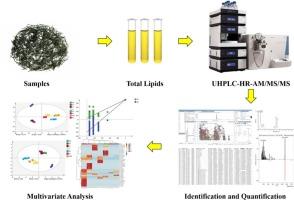用非靶向脂质组学和化学计量学相结合的方法测定和比较中国绿茶品种的脂质谱
IF 9.8
1区 农林科学
Q1 CHEMISTRY, APPLIED
引用次数: 0
摘要
茶是世界上消费最广泛的饮料。脂类作为茶叶的重要化学成分,与茶叶的风味和品质密切相关。然而,中国不同绿茶品种的脂质组指纹图谱信息有限。因此,本文采用非靶向脂质组学与化学计量学相结合的方法对中国绿茶品种进行鉴别。共鉴定出16个脂类147个分子种。绿茶样品显示出高水平的磷脂、糖脂、亚油酸和亚麻酸。它们在影响风味形成的代谢过程中发挥重要作用。并结合多变量数据分析,筛选出PC 16:0/18:3、MGDG 18:3/18:3、PC 18:2/18:2等8个分子种,用于鉴别绿茶品种。本研究为中国绿茶市场的质量保证和欺诈防范提供了参考。本文章由计算机程序翻译,如有差异,请以英文原文为准。


Determination and comparison of lipid profiles of Chinese green tea varieties using untargeted lipidomics analysis combined with chemometrics
Tea is the most widely consumed drink in the world. Lipids as important chemical components are closely related to the flavor and quality of tea. However, the information about the lipidomic fingerprints of different Chinese green tea varieties was limited. Therefore, an untargeted lipidomics analysis combined with chemometrics was applied for discriminating Chinese green tea varieties. A total of 147 molecular species belonging to 16 lipid classes were identified. And the green tea samples exhibited high levels of phospholipids, glycolipids, linoleic acid, and linolenic acid. They play important roles in metabolic processes that could influence flavor formation. Furthermore, combined with multivariate data analysis, 8 molecular species were screened out for discriminating green tea varieties, such as PC 16:0/18:3, MGDG 18:3/18:3, PC 18:2/18:2, etc. This study offers a reference for the guarantee of quality and the prevention of fraud within the Chinese green tea market.
求助全文
通过发布文献求助,成功后即可免费获取论文全文。
去求助
来源期刊

Food Chemistry
工程技术-食品科技
CiteScore
16.30
自引率
10.20%
发文量
3130
审稿时长
122 days
期刊介绍:
Food Chemistry publishes original research papers dealing with the advancement of the chemistry and biochemistry of foods or the analytical methods/ approach used. All papers should focus on the novelty of the research carried out.
 求助内容:
求助内容: 应助结果提醒方式:
应助结果提醒方式:


